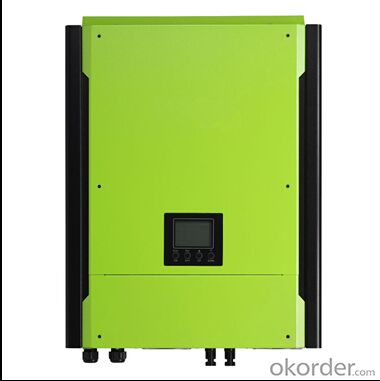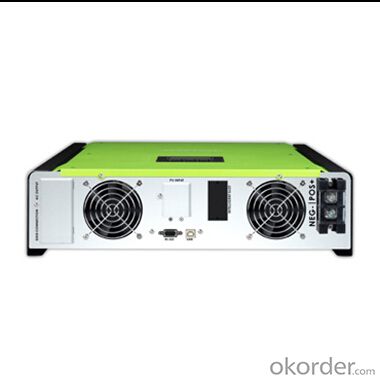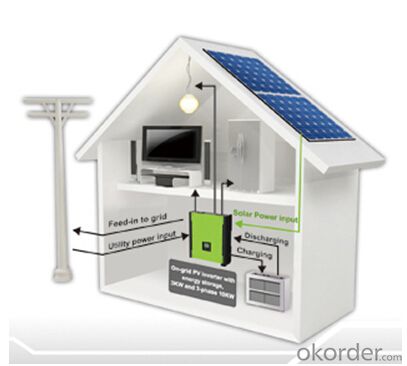On-Grid Energy Storage PV Inverter PH500 Series 1-phase 2KW
- Loading Port:
- China main port
- Payment Terms:
- TT or LC
- Min Order Qty:
- 60000 watt
- Supply Capability:
- 16000000 watt/month
OKorder Service Pledge
OKorder Financial Service
You Might Also Like
1. Structure of On-Grid Energy Storage PV Inverter Description
On-Grid Energy Storage PV Inverter is a hybrid inverter which combines solar system, AC utility, and battery power source to supply continuous power• It is suitable for the remote areas where the cost of utility is too high or emergency usage when utility is not stable.
2. Main Features of the On-Grid Energy Storage PV Inverter
• 2KW on-grid inverter with energy storage
• Pure sine wave output
• Microprocessor controlled to guarantee stable charging system
• Multiple operations: Grid tie, Off grid, and grid-tie with backup
• Built-in MPPT solar charger
• LCD display panel for comprehensive information
• Multiple communication
• Green substitution for generators
• User-adjustable battery charging current
3. On-Grid Energy Storage PV Inverter Images



4. On-Grid Energy Storage PV Inverter Specification
Model | PH500 Single-phase 2KW |
RATED POWER | 2000 W |
GRID-TIE OPERATION | |
PV INPUT (DC) | |
Maximum DC Power | 2250W |
Nominal DC Voltage / Maximum DC Voltage | 300 VDC / 350 VDC |
Start-up Voltage / Initial Feeding Voltage | 80 VDC / 120 VDC |
MPP Voltage Range | 150 VDC ~ 320 VDC |
Number of MPP Trackers / Maximum Input Current | 1 / 1 x 15 A |
GRID OUTPUT (AC) | |
Nominal Output Voltage | 101/110/120/127 VAC |
Output Voltage Range | 88 - 127 VAC* |
Nominal Output Current | 18 A |
Power Factor | > 0.99 |
EFFICIENCY | |
Maximum Conversion Efficiency (DC/AC) | 0.95 |
European Efficiency@ Vnominal | 0.94 |
OFF-GRID OPERATION |
|
AC INPUT | |
AC Start-up Voltage/Auto Restart Voltage | 60 - 70 VAC / 85 VAC |
Acceptable Input Voltage Range | 85 - 130 VAC* |
Number of MPP Trackers / Maximum Input Current | 30 A |
PV INPUT (DC) | |
Maximum DC Voltage | 350 VDC |
MPP Voltage Range | 150 VDC ~ 320 VDC |
Maximum Input Current | 1 / 1 x 15 A |
BATTERY MODE OUTPUT (AC) | |
Nominal Output Voltage | 101/110/120/127 VAC |
Output Waveform | Pure Sinewave |
Efficiency (DC to AC) | 0.9 |
HYBRID OPERATION | |
PV INPUT (DC) | |
Nominal DC Voltage / Maximum DC Voltage | 300 VDC / 350 VDC |
Start-up Voltage / Initial Feeding Voltage | 80 VDC / 120 VDC |
MPP Voltage Range | 150 VDC ~ 320 VDC |
Maximum Input Current | 1 / 1 x 15 A |
GRID OUTPUT (AC) | |
Nominal Output Voltage | 101/110/120/127 VAC |
Output Voltage Range | 88-127 VAC |
Nominal Output Current | 18 A |
AC INPUT | |
AC Start-up Voltage/Auto Restart Voltage | 60 - 70 VAC / 85 VAC |
Acceptable Input Voltage Range | 80 - 130 VAC* |
Maximum AC Input Current | 30 A |
BATTERY MODE OUTPUT (AC) | |
Nominal Output Voltage | 101/110/120/127 VAC |
Efficiency (DC to AC) | 0.9 |
BATTERY & CHARGER | |
Nominal DC Voltage | 48 VDC |
Maximum Charging Current | 25A |
GENERAL | |
PHYSICAL | |
Dimension, D x W x H (mm) | 420 x 415 x 170 |
Net Weight (kgs) | 15.5 |
INTERFACE | |
Communication Port | RS-232/USB |
Intelligent Slot | Optional SNMP, Modbus, and AS-400 cards available |
ENVIRONMENT | |
Humidity | 0 ~ 90% RH (No condensing) |
Operating Temperature | 0 to 40°C |
Altitude | 0 ~ 1000 m** |
5. FAQ of On-Grid Energy Storage PV Inverter
Q1. What is the difference between inverter and On-Grid Energy Storage PV Inverter?
A1. Inverter only has AC inpput, but On-Grid Energy Storage PV Inverter both connect to AC input and solar panel, it saves more power.
Q2. What is the difference between MPPT&PWM?
A2. MPPT has higher efficiency, it can track the max power point and won't waste energy.
Q3. What is the waranty of product?
A3. 12 months.
- Q:What is the role of a voltage regulator in a solar inverter?
- The role of a voltage regulator in a solar inverter is to maintain a consistent and stable output voltage despite fluctuations in the input voltage from the solar panels. It ensures that the electricity generated by the solar panels is converted and delivered to the connected devices or grid at the required voltage level, preventing any damage to the devices and optimizing the overall efficiency of the solar power system.
- Q:What is the function of a solar inverter?
- The function of a solar inverter is to convert the direct current (DC) electricity produced by solar panels into alternating current (AC) electricity, which can be used to power household appliances and be fed back into the electrical grid.
- Q:How does a solar inverter handle power factor correction?
- A solar inverter handles power factor correction by continuously monitoring the power factor of the electrical load and adjusting its operation accordingly. It applies various control techniques to ensure that the power factor is maintained close to unity, ultimately improving the efficiency and stability of the solar power system.
- Q:Does a solar inverter require a separate grounding system?
- Yes, a solar inverter typically requires a separate grounding system. This is because the solar panels generate direct current (DC) electricity, which needs to be converted into alternating current (AC) electricity by the inverter. The AC electricity is then fed into the electrical grid or used within the building. Grounding is an essential safety measure to protect against electrical faults and ensure proper functioning of the system. In a solar power system, the grounding system provides a path for electrical current to safely flow to the ground in the event of a fault, such as a short circuit or lightning strike. A separate grounding system for the solar inverter is necessary to prevent electrical shock hazards and to comply with electrical safety codes and standards. It helps to protect the equipment, the building, and the people using or working on the system. The specific grounding requirements for a solar inverter may vary based on local electrical codes and regulations. It is important to consult with a qualified electrician or solar installer to ensure that the grounding system is correctly designed and installed for optimal safety and performance.
- Q:Can a solar inverter be repaired or replaced if it malfunctions?
- Yes, a solar inverter can be repaired or replaced if it malfunctions. In many cases, minor issues can be fixed through repairs, such as replacing faulty components or updating firmware. However, if the inverter is extensively damaged or beyond repair, it may need to be replaced with a new one. Ultimately, the course of action will depend on the severity of the malfunction and the expertise of the technician assessing the situation.
- Q:Can a solar inverter be easily integrated into an existing electrical system?
- Yes, a solar inverter can be easily integrated into an existing electrical system. It is designed to convert the direct current (DC) power generated by solar panels into alternating current (AC) power that can be used by the electrical system. The inverter can typically be connected to the existing electrical system through a simple installation process, allowing the solar energy to be seamlessly integrated and utilized alongside the conventional power supply.
- Q:Can a solar inverter be used with a remote control system?
- Yes, a solar inverter can be used with a remote control system. Many modern solar inverters are equipped with built-in communication capabilities, such as Wi-Fi or Ethernet connectivity, which allows them to be remotely monitored and controlled. This enables users to adjust settings, monitor energy production, and receive real-time alerts or notifications through a remote control system.
- Q:Can a solar inverter be used with a solar-powered food dehydrator?
- Yes, a solar inverter can be used with a solar-powered food dehydrator. A solar inverter is responsible for converting the direct current (DC) produced by solar panels into alternating current (AC) that can be used to power electrical devices. Since a solar-powered food dehydrator typically requires AC power, a solar inverter is necessary to convert the DC power generated by the solar panels into the appropriate form for the dehydrator to function.
- Q:What is the role of a solar inverter in a solar-powered electric fence?
- The role of a solar inverter in a solar-powered electric fence is to convert the direct current (DC) electricity generated by the solar panels into alternating current (AC) electricity that can be used by the electric fence system. The inverter ensures that the voltage and frequency of the electricity are compatible with the electric fence equipment, allowing it to function effectively and safely.
- Q:How do I choose the right solar inverter for my system?
- When choosing the right solar inverter for your system, there are a few key factors to consider. First, determine the size and capacity of your solar panels to ensure compatibility. Next, consider the type of inverter you need, whether it's a string inverter, micro inverter, or power optimizer. Additionally, assess the efficiency and reliability of the inverter, as well as its warranty and after-sales support. Finally, consider your budget and any specific features you may require, such as monitoring capabilities or grid connectivity options. It's important to research and compare different models to find the one that best fits your specific solar system needs.
1. Manufacturer Overview |
|
|---|---|
| Location | |
| Year Established | |
| Annual Output Value | |
| Main Markets | |
| Company Certifications | |
2. Manufacturer Certificates |
|
|---|---|
| a) Certification Name | |
| Range | |
| Reference | |
| Validity Period | |
3. Manufacturer Capability |
|
|---|---|
| a)Trade Capacity | |
| Nearest Port | |
| Export Percentage | |
| No.of Employees in Trade Department | |
| Language Spoken: | |
| b)Factory Information | |
| Factory Size: | |
| No. of Production Lines | |
| Contract Manufacturing | |
| Product Price Range | |
Send your message to us
On-Grid Energy Storage PV Inverter PH500 Series 1-phase 2KW
- Loading Port:
- China main port
- Payment Terms:
- TT or LC
- Min Order Qty:
- 60000 watt
- Supply Capability:
- 16000000 watt/month
OKorder Service Pledge
OKorder Financial Service
Similar products
New products
Hot products
Hot Searches
Related keywords






























